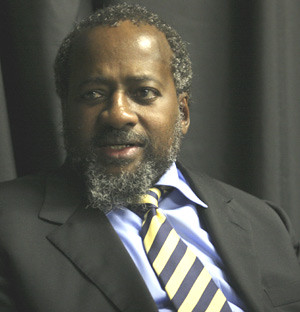
Former South African Minister of Communications, Pallo Jordan, responded to an article published in the South African press on the character of post-colonial development in Africa and Asia. Jordan contributed the response to ANC Today., a photo by Pan-African News Wire File Photos on Flickr.
Marking a turning point in SA liberation history
Mar 20, 2014
Z Pallo Jordan
Business Day Live
Many read the Sharpeville massacre as the apartheid regime’s declaration of war on the oppressed, who were obliged to respond with armed resistance, writes Z Pallo Jordan
AFTER the declaration of the first peacetime state of emergency on March 31 1960, army and police units laid siege to Cape Town’s African townships for five months. To enter or leave them, one ran the gauntlet of police checkpoints. At one such checkpoint, just outside Nyanga, a soldier shot dead a child on its mother’s back. That was the incident that inspired Afrikaans poet Ingrid Jonker’s poem dedicated to the African child.
Nelson Mandela incorporated Jonker’s Die Kind in his inaugural address to Parliament as democratic South Africa’s first president, as an act of affirmation and a gesture to acknowledge our common humanity, so eloquently expressed in the poignancy of her words.
Human Rights Day on Friday commemorates a turning point in the liberation struggle. On March 21 1960, the apartheid regime’s police killed 69 African demonstrators protesting against the pass laws at Sharpeville and three others in Langa township in Cape Town.
The "dompas", officially known as "a reference book", was the product of the cynically named Abolition of Passes and Consolidation of Documents Act. From the mid-18th century, passes had been used as a means of labour coercion and control over indigenous people. Like the Yellow Star and Pink Triangle that the Nazis imposed first on Germany and then on countries they occupied after 1939, the dompas was an emblem of exclusion and slavery.
It was an explicit statement that the bearer was someone to be regarded with suspicion, someone there on sufferance, The dompas had to be produced for inspection on demand. It was the official stamps, scribblings, signatures and endorsements in the dompas that gave officials and employers an account of the bearer’s movements, domicile, employment record, taxes paid and explained their presence.
Default in any of these made the bearer liable to criminal prosecution. In urban areas, these laws were enforced with regular "pass raids" on African communities, roadblocks where bus passengers were subjected to pass inspections, and in ambushes for the same purpose at railway and bus terminuses. Every year, thousands of African men and women were imprisoned and then deported to a so-called homeland in terms of these laws.
The 1960 Anti-Pass Campaign was borne on the winds of change sweeping through Africa, as then UK prime minister Harold Macmillan had pronounced that January. After 12 years in office, on March 21 1960, the apartheid regime suffered its gravest moral defeat. Glaring evidence that most of the dead were shot in the back was universally seen as illustrative of the brutal nature of South Africa’s racist regime. In the annals of repression modern communications entered Sharpeville as white South Africa’s response to Macmillan’s Winds of Change speech.
Since the end of the Anglo-Boer War, with a few exceptions, white political leaders sought to foster a shared white South African patriotism. Jan Smuts devoted his political career to it. After 1960, the National Party (NP) proved more successful than Smuts. The first indication of this trend was the outcome of the referendum of that year.
As he entered Parliament after his return from the 1961 Commonwealth Conference, Hendrik Verwoerd was saluted by a phalanx of blazer-clad Maties waving a Vierkleur, flag of one of the Boer republics. For the first time since 1948, the NP was able to win an outright majority of white votes in elections.
The decimation of the Progressive Party, which resulted in Helen Suzman’s 13 years as the lone voice of South Africa’s feeble liberalism in Parliament, confirmed the rightward swing in white South African politics. These developments reflected the switch by increasing numbers of English-speaking whites to the NP. The 1966 polls made its position unassailable as South Africa’s whites defied world opinion.
March 21 1960 was a watershed for the liberation struggle. A handful of mischievous pundits would like to convince us that the South African Communist Party manipulated the African National Congress (ANC) into adopting armed struggle. But the Pan-Africanist Congress (PAC), composed of former ANC members who had left it complaining of "communist influence", did likewise, as did some members of the anticommunist Liberal Party and the Trotskyists of the National Liberation Front.
They all read the Sharpeville massacre as the apartheid regime declaring war on the oppressed, who were obliged to respond with armed resistance.
The shock waves of the massacre stimulated the establishment of the Anti-Apartheid Movement in the UK. After the ANC and PAC were banned on April 7 1960, both went underground and launched an international campaign to isolate apartheid South Africa. From such small beginnings, activists in various parts of the world built the powerful international solidarity movement that could compel western governments to impose sanctions on apartheid South Africa.
A terrible yet eminently avoidable tragedy inspired Jonker’s poem. The murder of an innocent is among the horrors of an oppressive system, dehumanising those who enforce it. Yet, she ends it on a note of prophetic optimism: "The child grown into a giant traverses the world, without a dompas!"
• Jordan is a former arts and culture minister.
No comments:
Post a Comment